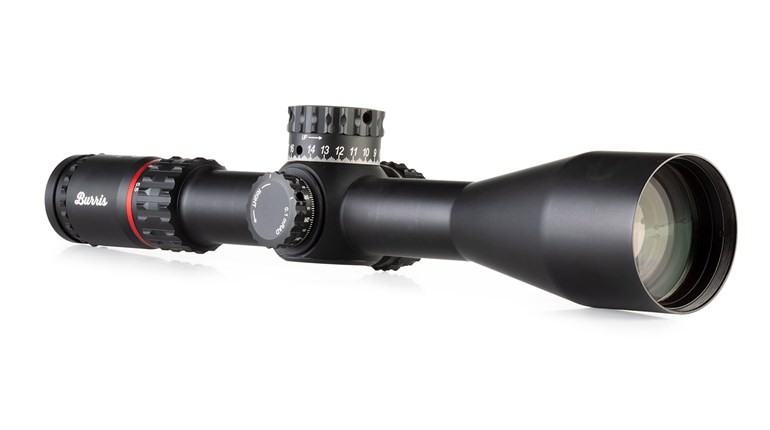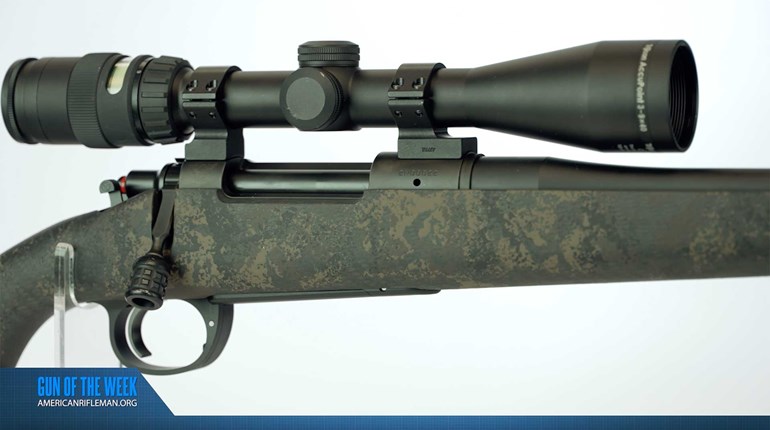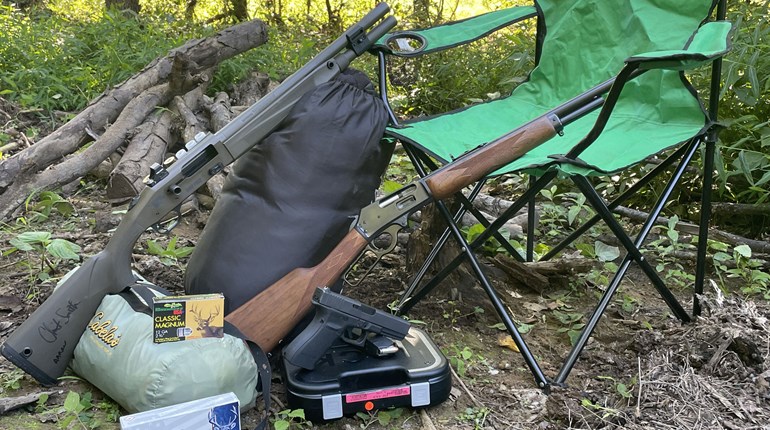
I watched the poor guy struggling to sight his rifle in; as if it wasn't bad enough that the stock length didn’t fit properly, he was getting chin-weld instead of cheek-weld. Later that week, he’d complain that the big buck he’d watched all fall came in at 30 yards, but he couldn’t quite get him in the scope. “All I saw was hair, but I couldn’t tell what I was looking at.” The issue: the gigantic, high-powered scope he had on top of his .30-06; it just didn’t make sense for the application.

Not that a 6x-18x-50mm scope doesn’t have its place in the shooting world, but on a deer rifle it’s probably a bit much. First of all, the huge objective lens required the scope to be mounted in high rings, and secondly, the magnification range was way more than necessary for hunting in the Northeast, where the majority of shots are well inside 100 yards, and any 200-yard shot is the cause for bragging.
Modern shooting scenarios have changed, even here in the wooded Northeast. Our shooting ranges are getting longer, our guns and cartridges are more accurate than they’ve ever been, and—sometimes sadly—longer shots at unwounded game are glorified, if not encouraged. I fully support practicing your marksmanship skills at longer ranges, in order to hone the ability to properly place your shot at sane hunting ranges. Exactly what that sane range is depends on your own abilities; I’ve spent enough time at the long-range shooting courses to have learned that I feel comfortable out to about 400 yards under good conditions, and if there are questionable winds, I want to get closer.

There is a reason that the 3x-9x riflescope is so popular: it truly does represent ‘enough scope’ and can cover nearly all hunting scenarios. Couple that the numerous improvements in lens quality and glass coatings, and you may find yourself surprised by how much you can do with a premium 3x-9x-40mm scope and its siblings; I like the new 13 ounce Leupold VX-3i 3.5x-10x with the CDS-ZL (Custom Dial System-ZeroLock) turret, as a highly flexible and lightweight choice for my Tikka T3x Lite in 7mm-08 Remington. It can be mounted low to the bore, and it maintains the lightweight qualities of that Tikka rifle. Over the years I’ve developed a few ideas when setting up different hunting rifles, which help me to maximize the versatility of the gun, cartridge and scope.
I want the best scope I can afford, and I will happily sacrifice magnification range for quality. In other words, I’d be much happier with a 1x-6x or even a 4x of premium quality than a 2x-10x of lesser quality. Premium scopes hold their zero better, and (generally speaking) have a better quality of lens, with better light transmission and a crisper image. They also tend to offer more generous eye relief, reducing the risk of scope eye. If you prefer the 30mm tube over the 1-inch, I can’t argue—the 30mm has more room for adjustment, if you prefer to dial for holdover, and tends to transmit more light—but I don’t feel it is imperative in the hunting world.
I also want the scope to be lightweight—to preserve the balance of the rifle—and to be capable of being mounted as low to the bore as possible. Most of our rifle stocks have a comb which is too low for many of the modern scopes, and that will drastically affect how the shooters’ face will sit on the stock. Ideally you want the comb to sit just under your cheekbone; when the scope is mounted too high (usually as a result of a large objective lens) the comb will align with your molars. In a hard-kicking rifle, this just sucks. And when you find the rifle that comes to shoulder like a fine shotgun, there is no easier way to ruin that balance than to screw an oversize, heavy scope on top of it.

When choosing a magnification, I look more to the low end than the high end. What I try to do is to envision the widest field of view I may need and start to form my decision from there. For example, if the rifle is one I may use in the thick deer woods, or for bears in the evergreen forests around New York, I look to a low end of 1x, 1.5x or 2x. This allows me the fast target acquisition to make shots at running deer, or for following up a bear in the thick vegetation of the early season. The Leupold 1.5x-5x-20mm Vx-3i is a classic for dangerous game in Africa and Alaska, but makes an excellent choice for almost of my hunting needs here in the Northeast. The 2x-12x-44mm Leupold VX-6HD gives a bit more top end, and for a rifle that will be in the elk woods, or hunting moose across a lake, this scope makes a great choice. For me, if I can’t get the job done on a big game animal with 12x magnification, I definitely need to get closer.
If you do most of your hunting at longer ranges, a scope with a bottom end of 3x or 4x isn’t a ridiculous prospect. Surely for the serious varmint rifle, the top end of 12x to 16x or even 20x can be useful, because you may be required to make a shot on a very small target at very long ranges, but I’ve seen a hunter blow an opportunity many times, simply by having the scope magnification turned up too high. While hunting mule deer in the wide-open prairie of South Dakota, I was carrying an EoTech VuDu 2.5x-10x-44mm scope on top of a Kimber 6.5 Creedmoor. While many would think that the higher end of that scope would be what would be relied upon, I took my mule deer offhand at 185 yards or so, with the scope set on 3.5x, with no issue at all.

I’ve also seen a strange phenomenon with high-magnification scopes, and it doesn’t happen all the time, but has happened enough to make it undeniable; some shooters shoot better at lower magnifications. Perhaps it is a subtle muscle twitch, trying to compensate for heartbeat in the scope at higher power, or perhaps it is a case of anxiety, but I've seen the same rifle and load have the group size cut in half when changing magnification from 15x or so down to 7x. Bizarre, I know, but it’s happened enough to be undeniable.
Maybe it’s time for an optic upgrade for your favorite rifle; there are some great values out there or maybe it’s the right time for that one high-end scope you’ve always wanted. Trijicon, Leupold, Zeiss, Vortex, Swarovski; they all have something to offer, though at many different price points. The new Bushnell stuff is very crisp and clear, and represents a good value for a scope on the higher end of the magnification range. Look to the weight of any prospective optic, and see how low the scope can be mounted. It will make an assured difference in the feel of your hunting rifle.
Want to read more from Philip Massaro? Check out the following articles:
• A Hunter's Guide to Staying Sane During the Coronavirus Outbreak
• Is Walnut Dead? Synthetic vs. Wood Stocks
• Rifles for the Traveling Hunter
• Top 5 Lever-Action Rifle Cartridges
• African Game Meat: What Happens After the Shot?
• Top 5 Underrated Deer Cartridges
• Top 5 Double Rifle Cartridges
• Deer Hunting: Were the Good Old Days Really That Good?
• Essential Gear for the Traveling Hunter
• 4 Reasons to Hate the 6.5 Creedmoor
• 4 Ways to Fine-Tune Your Rifle During the Off Season
• Review: Savage Model 110 AccuFit System
• Top 8 Bullets for African Plains Game
• Review: Tikka T3X Lite
• Top Bear Rifles and Loads
• 3 Rifle Cartridges to Hunt the World
• Why My Cartridge is Better Than Yours
• Top 5 Handgun Hunting Cartridges
• An Ode to the Ruger Model 77
• Top 5 Hunting Cartridges of the 21st Century
• Top 5 Deer Bullets for 2018
• An Ode to the .30-30 Winchester
• 5 Reasons to Book a Spring Bear Hunt
• An Ode to the Ruger Mini Thirty
• Boattail vs. Flat-Base Bullets
• How to Build a Custom Rifle
• Choosing a Cartridge for North America's Big Game
• Top 5 American-Made Hunting Rifles
• How to Choose a Buffalo Rifle
• An Ode to the .223 Remington
• Top 5 Coyote Cartridges
• The Ultimate Long-Range Hunting Cartridge
• The Greatest Whitetail Cartridge Ever Designed
• An Ode to the Browning BAR
• Top 5 Bear Bullets
• Do You Really Need a Magnum Cartridge?
• Why the Ruger No. 1 is Not No. 2
• Top 10 Mythical Game Species
• Top 5 Monometal Soft-Point Bullets
• Top 5 Subsonic .22 Long Rifle Loads
• The Most American Rifle Cartridge
• Tips for the Traveling Hunter
• How to Choose a Gun Safe
• Best Gun Cases for the Traveling Hunter
• An Ode to the .30-06 Springfield
• Top 5 Boutique Bullet Companies
• Top 5 .22 Long Rifle Loads
• 5 Reasons Round-Nose Bullets Are Still Cool
• Top 5 Dangerous Game Loads
• Top 5 Turkey Loads
• 5 Rifle Cartridges That Need to Make a Comeback
• Top 5 Safari Calibers
• 5 New Year's Resolutions for Hunters
• What Your Favorite Rifle Cartridge Says About You
• America's Most Wanted Cartridges
• America's Strangest Game Laws
• What Your Favorite Rifle Cartridge Says About You, Part II
• Top 5 Overrated Rifle Cartridges
• Top 5 Underrated Rifle Cartridges
• 5 Cartridges You Might Not Know About
• Top 5 Wildcat Cartridges
• An Ode to the Ruger Mini-14
• Top 5 Hog Loads
• Why .30-30 Winchester Will Never Die




































